Aug 2014
History Channel's Houdini can't unshackle itself
08/28/14 09:41 AM
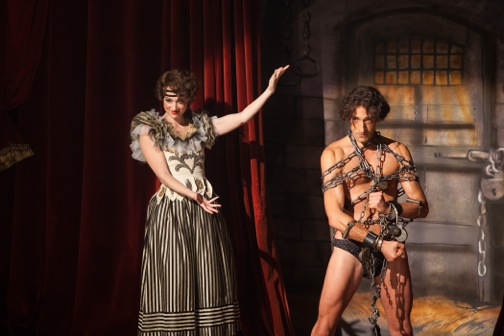
Premiering: Monday, Sept. 1st at 8 p.m. (central) on History Channel, with Part 2 at the same hour on Sept. 2nd.
Starring: Adrien Brody, Kristen Connolly, Evan Jones, Eszter Onodi, David Calder, Tom Benedict Knight, Louis Mertens
Produced by: Andras Hamon, Gerald W. Abrams
By ED BARK
@unclebarkycom on Twitter
Like any world class trickster, Harry “The Great” Houdini often used sleight of hand to great effect in fooling all of the public all of the time.
History Channel’s two-part depiction of his life and times, starring Adrien Brody, contrastingly uses a heavy hand throughout. Houdini suffers from an over-abundance of narration -- too much of it ridiculously written -- and recurring, clunky symbolism built around Houdini’s famed ability to take hard punches to the stomach. Viewers in turn get too many blows to the head, although there’s some fun to be had in seeing the secrets behind some of those daring escapes and illusions.
Born in 1874 as Erik Weisz of Budapest, the future Harry Houdini spent most of his formative years in Appleton, Wisconsin, where his mother bathed him in affection while his rabbi father kept stifling his hopes and dreams. History’s three-and-a-half-hour Houdini repeatedly revisits Harry’s veneration of his mother and distaste for a “nobody” father. Young Harry wanted to be somebody, ya see. Director Uli Edel and scriptwriter Nicholas Meyer keep pounding this home with all the subtlety of a pro wrestling body slam.
Monday’s Part One begins with a shackled Houdini poised to jump off a bridge into a small hole cut through an ice-encased river. From a distance, the “ice” looks very fake, but perhaps can still be touched up in post-production. Brody’s narrative voice -- get used to it -- informs viewers that “one way or another we all want to escape.” Except that “unlike other people, I don’t escape life. I escape death.” Although “the one thing I can’t seem to escape from is me.”
Houdini then flashes back 17 years to Ohio, where Harry is performing in a brothel. And then another decade to 1886 Appleton, where a young Harry (Louis Mertens) and his brother are captivated by a traveling magician who’s bloodily dismembering a woman before sawing her in half. Harry’s immediately got the bug while Brody keeps narrating the obvious before further intoning, “My greatest escape was leaving Appleton, Wisconsin.”
Brody, in one of Houdini’s early incarnations as “The Wild Man From Borneo,” has thrown himself into this role from a physical standpoint. His physique is chiseled to Tarzan-readiness -- and it appears to be all his. But the film is too full of flab and laughable voiceovers such as “The only thing more devastating than a punch to the gut is an arrow through the heart. I never even saw it coming.”
In this case, he’s talking about his first gaze at future wife Bess (Kristen Connolly), who’s a chorus line dancer. She very quickly becomes Houdini’s wife and onstage co-star before a prop whiz named Jim Collins (Evan Jones) becomes their indispensable third wheel. It’s Collins who’s the brains behind Houdini’s most famous escapes. And they hit the jackpot with the Chinese Water Torture Cell, into which a chained Houdini is lowered head first.
Houdini also became renowned for catching fired bullets in his teeth and for befuddling local cops who unsuccessfully sought to imprison him. The methods used are revealed in both instances. They in part reward a viewer’s patience for slogging through lines such as:
*** “The only way to beat death is to put your life on the line. But why was I so compelled to beat death? What was I trying to escape?”
*** “The bullets I pretended to catch in my teeth now struck young men throughout the world (at the outset of World War I).”
*** “My mother’s death was a sucker punch that I wasn’t near ready for.”
Houdini is relentlessly determined to leave no doubt that Houdini loved his mama Cecilia (Eszter Onodi) with an intensity that perhaps even Liberace, Van Cliburn and Elvis couldn’t match. Wife Bess just couldn’t keep pace, although they remained together through the rough patches.
“You may not be afraid of death but you’re afraid of life! Real life!” Bess blares in Tuesday’s Part 2.
“This is what you signed up for honey!” he retorts.
But Houdini eventually relents after upbraiding Bess for her opposition to his death-defying stunts.
“You put me in a box!” he rages. Oh yeah? “You’re only happy in a box! What’s next? A coffin?”
So Houdini grudgingly resorts to making elephants disappear and walking through brick walls. After the latter trick he meets Sir Arthur Conan Doyle (David Calder), the Sherlock Holmes creator who believes that both his wife and Houdini have spiritual powers.
“It’s a trick,” Harry keeps trying to tell him. They later clash over Houdini’s latter day quest to expose fake mediums by disrupting their seances. The film also presents as fact the still unproven claims that Houdini was recruited as a European spy for the U.S. Secret Service. It makes for some cloak-and-dagger meetings on foggy nights.
History Channel’s Houdini, flawed as it is, can’t help but be superior to the same-named, very broadly drawn 1953 film starring Tony Curtis. In that one, the cause of Houdini’s death was fabricated. The new version sticks to the actual facts, although Harry’s near-death exchange with an admiring doctor is mighty hokey.
Brody’s performance is borderline capable within the constraints of an at best mediocre combination of writing and story construction. But Harry Houdini’s incredible story still awaits a master re-telling. And this one doesn’t even come close.
GRADE: C-minus
Email comments or questions to: unclebarky@verizon.net
NBC's Emmy telecast is second most-watched in last 8 years
08/26/14 01:39 PM
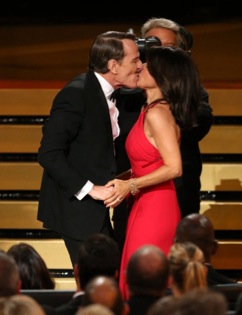
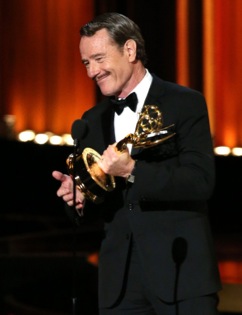
By ED BARK
@unclebarkycom on Twitter
Despite airing on a Monday instead of a Sunday for the first time since 1976, NBC’s Emmy telecast came up a pretty big winner in the national Nielsen ratings.
The three-hour ceremony, hosted by Seth Meyers, weighed in at 15.6 million viewers. That put it well behind last year’s total of 17.8 million, although there were extenuating circumstances. CBS’ 2013 telecast aired on Sunday, Sept. 22nd and benefited from a big lead-in audience from the network’s preceding NFL game between the New York Jets and Buffalo Bills.
NBC’s Emmys otherwise had more viewers than any ceremony since 2006, when NBC drew 16.2 million for “Television’s Biggest Night.”
The traditional broadcast networks held their own this time out, especially when compared to last year. Although host NBC and Fox were shut out, CBS, PBS and ABC combined for 11 major Emmys while the cable networks had 14. In the 2013 Emmys, cable and Netflix led the broadcasters by a score of 19 to 6.
AMC’s Breaking Bad, with a major finishing flourish, led all individual shows with five Emmys. ABC’s Modern Family (named best comedy for the fifth straight year) and PBS’ Sherlock: His Last Vow, tied for second with three apiece.
CBS, AMC and FX tied for the most network wins with five each while HBO dropped from a leading 7 last year to just 3 this year. Matthew McConaughey of HBO’s True Detective felt the sting, losing for the first time in any of this year’s awards ceremonies. The best actor in a drama series Emmy instead went to Bryan Crantson for Breaking Bad, which also repeated as TV’s best drama in the final award presentation of the night.
My cnn.com commentary on Monday’s Emmy Awards can be found right here.
Email comments or questions to: unclebarky@verizon.net
Emmys anyone? Read all about 'em
08/22/14 12:02 PM
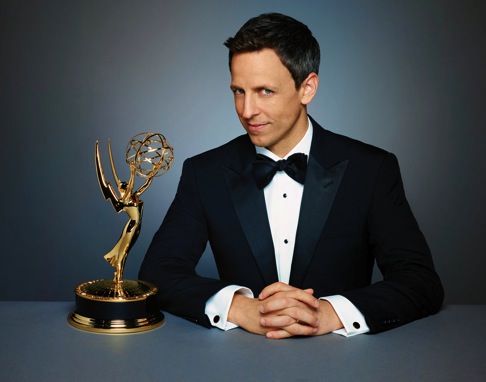
By ED BARK
@unclebarkycom on Twitter
The Emmys are coming, and you’re certainly entitled to yawn if you’d like.
Taking its turn in the four-network rotation, NBC will be carrying what they still like to call “Television’s Biggest Night.” It’s still too small, though, to dislodge the Peacock network’s contractual commitment to Sunday Night Football. So the Emmys are being sent to Monday, Aug. 25th (7 to 10 p.m. central) in deference to that bigger pre-season game Sunday night between the Cincinnati Bengals and Arizona Cardinals. Double yawn.
Seth Meyers is hosting, which promises to be both fun and relatively safe compared to the likes of Ricky Gervais or Seth MacFarlane. Answering a question from unclebarky.com at last month’s TV Critics Association “press tour,” Meyers says he’ll try to stay within the boundaries of an old rule of thumb from Lorne Michaels (his boss at Saturday Night Live and now at NBC’s Late Night).
“He always stresses to try not to tell a joke about somebody that you then would want to leave the cocktail party if they showed up,” Meyers says. “Even if it’s maybe a little negative, as long as it seems fair you can get away with it . . . You want to have a couple of jokes that you walk out not knowing exactly how they’re going to play. That makes it fun, sort of walking on the tightrope. So I think we’ll have some of that. But it’s more playful than certainly cutting or biting.”
The Emmys, now in their 66th year, have never generated office pools or watch parties like a certain other awards ceremony dedicated to recognizing excellence on the big screen. Far more people watch television than go to movie theaters. And the TV bar is set higher than ever, with quality drama and comedy series being launched here, there and almost everywhere. Still, the Oscars are King Tut while the Emmys remain the forever-in-waiting equivalent of Prince Charles. Someday their cachet will come. But probably not during many of our life times.
Emmy’s categories also are a particular mess this time around, with networks and shows pretending to be something they’re not in order to enhance their chances of at least being nominated. Netflix’s Orange Is the New Black is a comedy series nominee. Hah! Treme got a nomination as a miniseries, even though it ended its run in December after four seasons on HBO. In this view, anything airing in successive seasons under the same title is a series -- not a miniseries.
There are other instances of category malfeasance. But absent a groundswell of opposition -- and there’s certainly nothing close to that -- let’s deal with the hands that will be dealt Monday night. Here are the nominees in some of the major categories, with your friendly content provider in each case offering a brief closing commentary.
OUTSTANDING DRAMA SERIES
Breaking Bad (AMC)
Downton Abbey (PBS)
Game of Thrones (HBO)
House of Cards (Netflix)
Mad Men (AMC)
True Detective (HBO)
Comment: Breaking Bad is the defending champ and could break through again for its final season. But I’m going with an upset win by Game of Thrones, an international phenomenon that led all Emmy nominees this time with 19. True Detective is a contender, too.
OUTSTANDING COMEDY SERIES
The Big Bang Theory (CBS)
Louie (FX)
Modern Family (ABC)
Orange is the New Black (Netflix)
Silicon Valley (HBO)
Veep (HBO)
Comment: Modern Family has won four of these in a row. I think that streak will be ended by Veep. There’s also likely to be solid support for Orange is the New Black. But it’s far more a drama than a comedy series, and there’s a chance it might not have even been nominated in that category. I hope that more than a few Emmy voters take that into account and reward a rightful comedy, not a pretender.
OUTSTANDING MINISERIES
American Horror Story: Coven (FX)
Bonnie and Clyde (A&E/Lifetime/History)
Fargo (FX)
Treme (HBO)
The White Queen (Starz)
Comment: Fargo should be a lock. And in this case I liked it way too much to quibble over whether it’s more of a series than a miniseries. American Horror Story: Coven is the only other conceivable winner in this category. That would be a big upset, though.
OUTSTANDING TELEVISION MOVIE
Killing Kennedy (National Geographic Channel)
Muhammad Ali’s Greatest Fight (HBO)
The Normal Heart (HBO)
Sherlock: His Last Vow (PBS)
The Trip to Bountiful (Lifetime)
Comment: The Normal Heart is a certain winner here.
LEAD ACTOR IN A DRAMA SERIES
Bryan Cranston (Breaking Bad)
Jeff Daniels (The Newsroom/HBO)
Jon Hamm (Mad Men)
Woody Harrelson (True Detective)
Matthew McConaughey (True Detective)
Kevin Spacey (House of Cards)
Comment: Daniels was last year’s upset winner, but that won’t happen again. McConaughey hasn’t lost yet in any awards competition, and he’s the very likely winner. Some might see a possible vote-split between McConaughey and co-star Harrelson. But Michael Douglas kept on winning in 2013 while co-star Matt Damon kept losing for his work in HBO’s Behind the Candelabra. Hamm almost assuredly will walk away empty-handed again, which is unfortunate. Cranston is very much liked in Hollywood. So if McConaughey somehow is denied, look for Cranston to be the one hoisting the Emmy.
LEAD ACTOR IN A DRAMA SERIES
Lizzy Caplan (Masters of Sex/Showtime)
Claire Danes (Homeland/Showtime)
Michelle Dockery (Downton Abbey)
Julianna Margulies (The Good Wife/CBS)
Kerry Washington (Scandal/ABC)
Robin Wright (House of Cards)
Comment: Although her series isn’t of Emmy caliber, Washington is my pick to win. As an Emmy voter, though, I’d go with Caplan, the Masters of Sex co-star who’s also the sexiest woman in series TV. That’s just a personal opinion, though. Danes won last year. And the year before that.
LEAD ACTRESS IN A COMEDY SERIES
Lena Dunham (Girls/HBO)
Edie Falco (Nurse Jackie/Showtime)
Julia Louis-Dreyfus (Veep)
Melissa McCarthy (Mike & Molly/CBS)
Amy Poehler (Parks and Recreation/NBC)
Taylor Schilling (Orange is the New Black)
Comment: I think Louis-Dreyfus will defend her title in this category. Even Falco has said she doesn’t think Nurse Jackie is a comedy, which was easier for her to say after she earlier won in the title role. In contrast, Poehler has never won an Emmy but has a Peabody and a Golden Globe. If she finally breaks through, that’d be nice.
LEAD ACTOR IN A COMEDY SERIES
Louis C.K. (Louie)
Don Cheadle (House of Lies/Showtime)
Ricky Gervais (Derek/Netflix)
Matt LeBlanc (Episodes/Showtime)
William H. Macy (Shameless/Showtime)
Jim Parsons (The Big Bang Theory)
Comment: The last I looked, Shameless is not and never has been a comedy. Nor does this category generate much interest on my part. They might well give it to Parsons again, which would be OK. But I’d rather see Louis C.K. or LeBlanc win, even though the latter is playing a heightened version of himself. Neither has ever won an acting Emmy.
LEAD ACTOR IN A MINISERIES OR MOVIE
Benedict Cumberbatch (Sherlock: His Last Vow)
Chiwetel Ejiofor (Dancing on the Edge/Starz)
Idris Elba (Luther/BBC America)
Martin Freeman (Fargo)
Mark Ruffalo (The Normal Heart)
Billy Bob Thornton (Fargo)
Comment: Billy Bob almost certainly will win this one. But Freeman was tremendous, too. If they somehow divide the vote, Ruffalo could emerge triumphant in the sort of “cause” movie that Hollywood keeps loving.
LEAD ACTRESS IN A MINISERIES OR MOVIE
Helena Bonham Carter (Burton and Taylor/BBC America)
Minnie Driver (Return to Zero/Lifetime)
Jessica Lange (American Horror Story: Coven)
Sarah Paulson (American Horror Story: Coven)
Cicely Tyson (The Trip to Bountiful)
Kristen Wiig (Spoils of Babylon/IFC)
Comment: Bonham Carter was very good in Burton and Taylor, but Tyson has sentiment and a long, distinguished history on her side. She may well win, and it could be quite a moment if she does.
One last thing: I’m not including the supporting categories, but my night with the Emmys would be complete if Allison Tolman prevails as the “Best Supporting Actress in a Miniseries or Movie.” The Baylor University grad and former Dallas resident was a true out-of-nowhere success story as dedicated deputy Molly Solverson in Fargo. She’s up against a quintet of name brands -- Kathy Bates, Ellen Burstyn, Julia Roberts, Angela Bassett and Frances Conroy. But c’mon, let’s make the correct choice here. And without a doubt that would be Tolman, the heart and soul of Fargo in her first role of any import.
Email comments or questions to: unclebarky@verizon.net
BBC America's Intruders is more off-putting than involving
08/21/14 01:44 PM
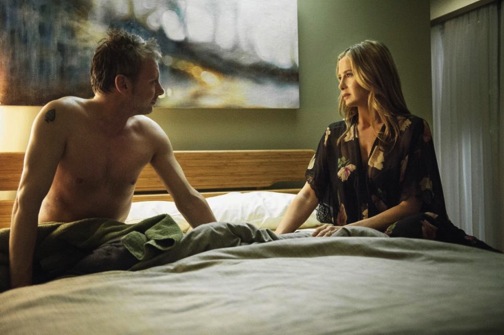
John Simm & Mira Sorvino have very little time for this in Intruders. BBC America photo
Premiering: Saturday, Aug. 23rd at 9 p.m. (central) on BBC America
Starring: John Simm, Mira Sorvino, James Frain, Millie Brown, Tory Kittles
Produced by: Glen Morgan, Jane Tranter, Julie Gardner, Rose Lam
By ED BARK
@unclebarkycom on Twitter
Story continuity isn’t the only problem with BBC America’s Intruders.
Early in Episode 1, a brief kitchen counter make-out scene makes it look as though Mira Sorvino rather magically has her robe off, on, off, on and off again. Upon further review, this is supposed to be some sort of arty, sleight-of-hand sequence shot from two angles. Unfortunately it also foreshadows the crazy-quilt makeup of this discombobulated tale, which furthermore is set in the “moody” Pacific Northwest, as described in BBC America publicity materials.
Four of the eight hour-long episodes were made available for review. That’s a considerable investment in time before hitting the desktop keyboard and rendering judgment. I kept wanting Intruders to get a grip on itself and in the process become more gripping. Instead it toggled to and fro, gradually making a little more sense while taking way too much time to do so. Being neck-deep in a muddy, murky eerie canal gets tiresome in due time. And the performances aren’t all that hot either in this adaptation of Michael Marshall Smith’s 2007 novel.
Sorvino is the marquee name, but her character isn’t the central figure of Intruders. That job goes to John Simm as former LAPD officer Jack Whelan, whose book Afterlife is now available in stores dotting the picturesque coastal town of Birch Crossing, WA. Whelan, who left the force after a violent incident, is newly dedicated to living quietly with his wife, Amy (Sorvino). But she soon vanishes amid the drama’s multiple story lines in venues ranging from Finley Beach. Oregon to Reno, Nevada.
Intruders begins with a surfeit of spooky music and drum-pounding at a teen girl’s 1990 birthday party in Barstow, CA. Two mysterious men eventually invade her bedroom. One of them is played by the redoubtable and always welcome Robert Forster, who’s briefly shown saying, “Donna, can you keep a secret? It’s a secret that you gave to us. We’re here to give it back to you, just as you asked all those years ago. We’re just here to shepherd you.”
She next vomits, of course, before writhing around, writing a “not Donna” letter and then drowning herself in a bathtub of blood. Then it’s on to present-day Seattle, where a marauding assassin named Richard Shepherd (James Frain) blows away a mom and her son while searching for an engineering professor whose knowledge could be dangerous to a very sinister secret society known as Qui Reverti.
The other featured characters are Jack’s old high school buddy, Gary Fischer (Tory Kittles), and a nine-year-old girl named Madison O’Donnell (Millie Brown), who’s both possessed and dangerous. Gary turns out to know a lot more about Jack’s duplicitous wife while Madison drowns her purring cat in a bubble bath before wailing “What have I done?” near the end of Saturday’s Episode 1. You may want to stop watching right there.
In subsequent episodes, Richard keeps killing, Jack keeps searching and kid Madison spews profanity -- “So limp dick, there’s some shit I need from you” -- that often ends with the tagline, “What goes around comes around.” Then again, she’s sometimes not in her right mind.
Sorvino is largely out of the picture in Episodes 2 and 4, leaving Simm to do most of the heavy lifting. Frankly, he’s not much of a leading man in a drama that requires some standout acting and a galvanizing presence to offset all the detours and plot knots. Sorvino and Simm try to rally these proceedings with an extended, boozy confrontation in Episode 3. “You saved me. Let me save you,” he finally pleads. Too little too late -- in every respect.
A lot of Intruders is shot at night, which perhaps is fitting for a drama that leaves viewers too much in the dark. Those willing to be strung along on the quest for immortality front would do far better to catch up or stay with FX’s ongoing The Strain. Intruders, in contrast, just can’t seem to breathe sustaining life into its characters or storyline.
GRADE: C
HBO's Captivated: The Trials of Pamela Smart: Implanting "reality TV" with the first fully televised trial
08/14/14 10:41 AM
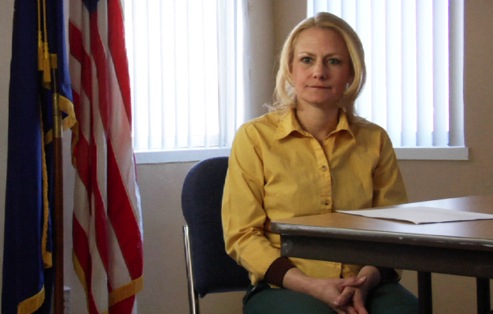
By ED BARK
@unclebarkycom on Twitter
It’s often the opposite outcome in sensational trials soaked in saturation TV coverage.
Defendants O.J. Simpson, Robert Blake, Casey Anthony, Michael Jackson, George Zimmerman and the four Los Angeles police officers who beat Rodney King on videotape are among those who have been controversially acquitted of their alleged crimes.
Not so Pamela Smart, who went on trial 23 years ago for the first degree murder of her husband, Gregg, to whom she had been married for just under a year. The HBO documentary Captivated: The Trials of Pamela Smart (premiering Monday, Aug. 18th at 8 p.m. central) finds the roots of “reality TV” embedded in a guilty verdict that sent the defendant to prison for life with no possibility of parole. Smart, now 46, still maintains her innocence and in large part blames the media for her conviction.
The entire Smart trial, which also spotlighted her four wrong-side-of-the-tracks male teenage accomplices, was televised live daily on New Hampshire’s WMUR-TV. It marked the first time that cameras were allowed in the courtroom from gavel to gavel. Filmmakers Jeremiah Zagar and Lori Cheatle view this as an electronic age equivalent of Adam biting the apple before all hell broke loose. The Smart trial riveted the entire town of Derry, NH while various reporters, law enforcement officials, lawyers and witnesses came to relish their supporting roles.
One of the one hour, 40 minute documentary’s money quotes is from reality show producer Ted Haimes, whose recent credits include Starving Secrets with Tracey Gold, Aftermath with William Shatner, The Locator and Adoption Diaries.
“We were seeing the petri dish for what’s happened today,” Haimes says of the Smart trial and its attendant circus. “TV has gone from being something that you watch to being something you’re in.”
Young gun WMUR reporter Bill Spencer, who then and now is not shy about his prominent role in fleshing out the Smart story, became a telegenic go-to guy on daytime talk shows hosted by Phil Donahue, Geraldo Rivera, Sally Jessy Raphael and others.
Rivera of all people asked him, “Any chance that the media is on a runaway stampede with this case?”
“No, I don’t think so,” he said.
Spencer also anchored the WMUR special Anatomy of a Murder, which aired shortly before jury selection began in the Smart trial. It pretty much fingered her and of course drew big ratings.
“We publicized the heck out of it,” Spencer recalls. Smart’s appeals lawyer, J. Albert Johnson, says the program made it virtually impossible to select an unbiased jury. “You can’t un-ring the bell” he argues.
Derry police Sgt. Dan Pelletier, who arrested Smart, says that Captivated is, by his count, the seventh TV program he’s done in connection with the case. He’s still conscious of what amounts to his TV acting, asking the filmmakers to “let me go back and find a little more emotion.” On his second take, Pelletier is more animated in again reciting what he told Smart on that day. He had some good news and some bad news for her. They’d solved the murder and she was under arrest.
Captivated also includes a new interview with Smart; audio tapes secretly recorded by “Juror #13” (who was skeptical about the guilty verdict); and the first interview with fellow defendant Raymond Fowler after his parole period ended in 2013. He believes the jury reached the right verdict while others say he has come to believe the evil depiction of Smart in a 1991 TV movie, Murder in New Hampshire: The Pamela Wojas Smart Story. Helen Hunt played the title role while Spencer played himself.
A 1995 feature film, To Die For, also borrowed heavily from the Smart case. It starred Nicole Kidman and was adapted from the same-name book by Joyce Maynard, who says in Captivated, “The archetype of the beautiful woman brought down is a very powerful one.”
The Smart trial also co-starred a beautiful young boy, 15-year-old Billy Flynn, who testified in court to being the trigger man after having an affair with Smart that she’s never denied. Archival footage from the 1991 coverage of the trial has one avid viewer comparing Flynn to Paul McCartney. He’s still in jail but eligible for parole in 2015.
Captivated doesn’t come right out and say that Smart got railroaded by a runaway media train. But it clearly doesn’t mind implanting this idea with a new generation of viewers. The basic purpose of the film is to prove its thesis that “a black hole of media attention,” as appeals lawyer Johnson puts it, did far more harm than good to both Smart and the legal process.
Some of the visuals can be a little much. A worn, heavily scratched tape recorder, shot in closeup and occasionally revolving full circle, is used in tandem with the frequent audio from Juror #13. Smart also feared birds and talked of having a nightmare about them during one of her taped conversations with wired police informant Cecelia Pierce, who came to very much crave the media spotlight. So Captivated begins and ends with flocks of birds, signifying not much of anything, really.
This is nonetheless an absorbing and aggressive film that makes its points forcefully.
Smart, who clings to hopes she’ll be free someday, is not immune to envisioning the media possibilities beyond that.
“What a crazy movie it’ll be if I get out. Right?” she says near the end of Captivated.
It recalls what Spencer says about her early in the film. He was interviewing Smart in her home when she told him she still had the top layer of her wedding cake in the freezer. Wouldn’t it be a great picture if she posed with it?
“She’s attempting to produce the story that I’m working on!” Spencer exclaims all these years later.
In reality he didn’t mind a bit.
GRADE: B+
Email comments or questions to: unclebarky@verizon.net
"Press tour" tales: How do you like your comedy?
08/13/14 01:33 PM
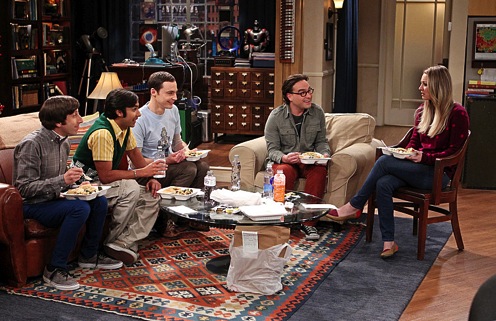
By ED BARK
@unclebarkycom on Twitter
BEVERLY HILLS, CA -- Single-cam vs. multi-cam.
The look and feel of a prime-time sitcom greatly depends on these two basic delivery systems.
Multi-cam: filmed or taped in a single night before a live studio audience, with laugh track “sweeteners” deployed when deemed necessary. The humor tends to be broader. Which isn’t to say it’s automatically more sophomoric.
Single-cam: filmed in separate stages out of sight of a studio audience. Laugh tracks are very seldom included. The humor tends to be lower-key and perhaps more “natural.” Not that belly laughs aren’t welcome.
One network continues to thrive with the old school, multi-cam form dating all the way back to I Love Lucy. So it’s no coincidence that this is still how CBS rolls.
NBC in part has tried to emulate CBS in hopes of generating more “mainstream” hit comedy classics such as the Peacock’s studio audience-fueled Seinfeld, Cheers, Frasier, Friends and The Cosby Show. But that’s been a bust of late. So NBC’s new fall lineup has gone back to the single-cam play list with Marry Me, A to Z and Bad Judge after striking out in recent seasons with multi-cam sitcoms such as Sean Saves the World, Whitney and the Jimmy Fallon-produced Guys with Kids.
During network executive sessions at the recent Television Critics Association “press tour,” unclebarky.com quizzed the entertainment bosses at CBS and NBC on why they do the things they do on the comedy series front.
CBS entertainment chairman Nina Tassler strayed onto the single-cam path last season with The Crazy Ones, which ended up being a high-profile cancellation starring the now tragically late Robin Williams and Sarah Michelle Gellar. But the network succeeded with two multi-cam sitcoms, The Millers and Mom. They’ll be back for second seasons this fall along with prime-time’s most popular comedy, The Big Bang Theory. It’s also a multi-cam, as are CBS returnees Two and a Half Men, 2 Broke Girls and Mike & Molly.
“They’re definitely harder to do,” Tassler contends. “But for us, the emphasis on being able to craft and score with hard jokes -- we are particularly good at it. I think we have a very keen ability to identify those talents who can really deliver that kind of comedy.”
CBS’ lone new sitcom this fall, The McCarthys, began as a single-cam comedy before the network in a sense came to its senses.
“A lot of people are very seduced by the romance of a single-camera comedy,” Tassler says. “But when we looked at the rhythms of The McCarthys (centered on a boisterous Boston family), it was much better served in a multi-camera format. Ultimately, for our network and for our audience, they resonate.”
Is that because the still generally older CBS audience remains conditioned to reject sitcoms without a laugh track? Not really, Tassler says, citing the long-running success of How I Met Your Mother as “more of a hybrid comedy” that was filmed before a studio audience but “had its own rhythm.”
Still, “our audience does appreciate the level of humor that multi-cams deliver,” she says.
There’s one other major factor -- producer Chuck Lorre. He’s always worked in the multi-cam format, and he runs Big Bang as well as Two and a Half Men, Mike & Molly and Mom. You want to keep a guy like that happy.
“A lot of the work that’s done in single-camera is post-filming, a lot in the edit room,” Tassler says. “A multi-cam really cuts its teeth on its feet, on the stage. And that’s why I think we’re really successful with it.”
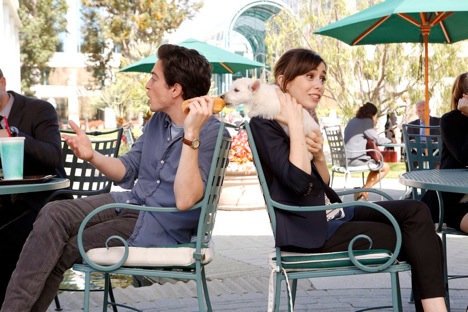
CBS won’t have any single-cam comedies on its schedule in the coming season. NBC will be without any multi-cams this fall.
“We talk about this all the time,” says Bob Greenblatt, NBC’s entertainment chairman. “We keep going back to the fact that some of the best shows on television (and also the biggest hits) were multi-cam comedies with live studio audiences. Yet, there’s been a generation of shows that have moved away from that, from (NBC’s) The Office to even (ABC’s) Modern Family, which easily could have been a show with a studio audience in the way it was shot. But they chose not to do that.”
Modern Family has been the biggest mass audience single-cam hit of the modern era. The Office also endured, but as more of a “demographic” darling with particular appeal among advertiser-prized 18-to-49-year-olds. NBC otherwise has struggled to find anything close to big audiences for critically praised single-cam comedies such as 30 Rock, Community and Parks and Recreation. That’s principally why Greenblatt admittedly yearned to crack the multi-cam code and live large the way CBS has with top 10 hits such as Big Bang, Two and a Half Men and, before that, Everybody Loves Raymond.
But “there’s a generation of writers and producers who have gone away from the multi-cam,” Greenblatt says. “Nine times out of 10, they come in wanting to write a single-cam . . . There was such a cachet with The Office and 30 Rock. And there was a whole rash of (single-cam) shows that were Emmy-nominated or awarded. It kept being reinforced that single-cameras are the better form. And I really hope we can balance the scales a little bit.”
Greenblatt notes that NBC plans to take another multi-cam shot at midseason with One Big Happy, a comedy whose executive producers include Ellen DeGeneres. And perhaps by next summer or fall 2015, a previously announced “multi-generational” multi-cam sitcom starring Bill Cosby will be ready to roll.
“That’s an important show for us,” says NBC entertainment president Jennifer Salke. “We’re very committed to multis, but again it’s who really wants to write one.”
For the record, ABC has one freshman multi-cam sitcom, Cristela, for the fall, and two new single-cams (Black-ish and Selfie). Fox will take another shot at the multi-cam form with the new comedy Mulaney while returning three of its “Animation Domination” series and a trio of live action, single-cam comedies.
Email comments or questions to: unclebarky@verizon.net
R.I.P. Robin Williams: July 21, 1951 to Aug. 11, 2014
08/12/14 11:54 AM
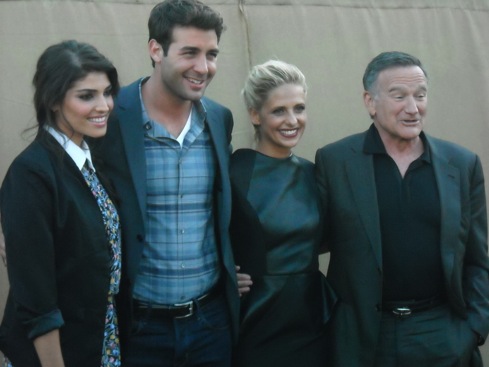
Robin Williams and co-stars of CBS’ The Crazy Ones last summer. Photo: Ed Bark
By ED BARK
@unclebarkycom on Twitter
It’s been a struggle, both coming to grips with Robin Williams’ death and striving to say something that hasn’t been said already during this ongoing outpouring of grief and appreciation.
I’ve settled on excerpts from four previous articles that touch on both the pain and the glory of being a world-renowned actor-comedian who tended to drill deeper than many of us remember. Williams, who succumbed to depression by apparently committing suicide at the age of 63, added up to a lot more than “Mork from Ork.”
I’d forgotten reviewing him in a May 4, 1987 PBS Great Performances adaptation of novelist Saul Bellow’s Seize the Day. There was nothing funny about it.
“Robin Williams’ mugging is near-legendary, but his mug has a permanent droop,” I wrote. “Oh how he suffers.”
Williams, just five years removed from the end of Mork & Mindy’s run on ABC, played Tommy Wilhelm, a fallen salesman/failed actor whose imperious father, Dr. Adler, specialized in belittling him.
According to dad, “You know what you are in this world without money? Nothing. Absolutely nothing.”
Tommy also was estranged from a wife who viewed him as a pitiful whiner. “Neither is Tommy’s self-esteem heightened by a Hollywood agent’s big plans for him,“ I wrote. “In a flashback scene, the stogie-puffer proclaims, ‘I got you pegged as the kinda guy who loses the girl to George Raft.’ “
Williams’ performance was praised as “smashingly good” in a “drama so dark that the only hint of a grin comes when an old lady’s matched weiner dogs urinate in a hotel lobby and then in the elevator carrying Tommy up for another downer with his father. Tommy is little more than a near-40-year-old mutt with the terminal look of a hurt puppy.”
***
In his later years, Williams starred as Lance Clayton, a sad sack high school poetry teacher whose only son viewed him as a pathetic loser.
“It’s like Dead Penis Society,” Williams joked to TV critics in 2009 while otherwise promoting his latest HBO standup special at a time when he was still on the mend from open-heart surgery.
Directed and written by Williams’ longtime friend, Bobcat Goldthwaite, World’s Greatest Dad was financed by Mark Cuban’s Magnolia Pictures and premiered on his HDNet Movies network before opening and quickly closing in theaters.
“The film is well-paced, never dull and headed toward a not entirely unpredictable but satisfying denouement,” I wrote at the time. “Williams, whose occasional serious side has come out in films such as Good Will Hunting, Insomnia and One Hour Photo, is particularly effective when not knowing whether to laugh or cry. Witness his character’s appearance on the Dr. Phil-like Dr. Dana TV show, where Williams turns in a few minutes of at least borderline brilliance.”
As with Seize the Day, the pain was palpable and for the most part, unrelenting. Or as the review’s first paragraph put it, “Morbidly fascinating and achingly watchable, World’s Greatest Dad pairs a hellish son with a rejected, dejected father whose would-be novels have yet to see print.”
***
A few years earlier, Williams found himself on the receiving end of NBC’s Behind the Camera: The Unauthorized Story of Mork & Mindy. The 2005 scripted film came after the Peacock network had pecked away at the undersides of three previous ABC hits -- The Partridge Family, Three’s Company and Charlie’s Angels.
A then unknown Chris Diamantopoulos, who went on to play Moe Howard in 2012’s The Three Stooges feature film, co-starred as a manic Williams whose “once-heavy cocaine habit and friendship with self-destructive John Belushi (Tyler Labine) are voyeuristically telescoped.”
The film took extreme liberties with anything resembling the facts. One scene depicted Williams finding Belushi flat on his back outside a bar. “Oh look,” he said. “A star on Hollywood Boulevard. Don’t you have to be dead to get one of those?”
Belushi was found dead of a drug overdose in 1982 at the Chateau Marmont hotel. The film showed Williams telling his near-comatose friend, “If you ever wake up, call me.”
To my knowledge, Williams never publicly complained about the film, which NBC should be ashamed of to this day. But it must have pained him to know it was out there.
***
I also reviewed Williams’ return to the standup comedy stage after a 14-year absence. He had an April, 2002 engagement in Dallas, performing for an hour and 45 minutes before a sold-out crowd at Fair Park Music Hall, capacity 3,420.
By the end of it all, “he has successfully sweated another Rorschach pattern through the front of his untucked black shirt,” I wrote.
Williams opened with a Jerry Jones joke after lampooning the Dallas Cowboy owner’s obvious facial adjustments. “Now if only they could sew his (expletive) mouth shut,” he said.
Here are a couple of other paragraphs from that review:
“Draining bottled water like a man who had just been fed a dozen peanut butter sandwiches intravenously, Williams has downshifted slightly from the wildly improvisational comic he used to be. His routines are more practiced now, and some have been around a while. But the humor remains far more guttural and profane than that of a suit-and-tied Jerry Seinfeld, who played Arlington in late January and will take the Music Hall stage later this month.
“Williams’ big finish, before a 10-minute encore, had him nearly blowing a gasket while demonstrating the considerable powers of Viagra. He used a bottle of water as a veritable Niagra for this one before digging his face into the crook of his arm in another sexual simulation that had the crowd nearly crazed with laughter.”
During the encore -- and this still probably happened wherever he went -- an audience member loudly yelled “Mork!” while Williams was trying to talk about his increasingly strong-willed 12-year-old daughter.
“Not Mork, you (expletive),” he rejoined. “Mork died 20 (expletive) years ago! This is Robin!”
Pause, one-two.
“I shouldn’t be bitter,” Williams added. “It bought me a ranch.”
Email comments or questions to: unclebarky@verizon.net
TNT's Legends at least will keep Sean Bean upright
08/11/14 02:41 PM
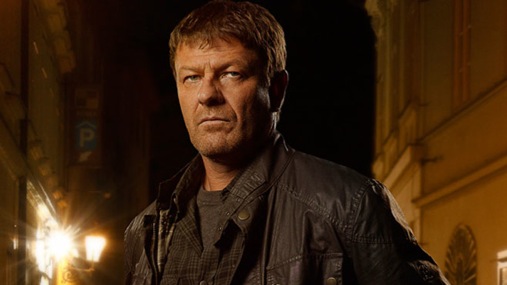
Sean Bean can be confident of cheating death for a while in Legends. TNT photo
Premiering: Wednesday, Aug. 13th at 8 p.m. (central) on TNT
Starring: Sean Bean, Ali Larter, Steve Harris, Tina Majorino, Morris Chestnut, Amber Valletta, Mason Cook
Produced by: Howard Gordon, Alexander Cary, Jonathan Levin, Brad Turner, David Wilcox
By ED BARK
@unclebarkycom on Twitter
Having lost his head in Season 1 of Game of Thrones, Sean Bean already has a gun to his head before the title credits roll in TNT’s Legends.
The trigger is pulled and . . . click. Bean has no serious worries this time out after vivid demises in Game of Thrones, The Lord of the Rings: The Twin Towers, Patriot Games and the James Bond movie GoldenEye. TNT enjoys a little gallows humor, though, distributing “#DontKillSeanBean” t-shirts for last month’s Legends session at the Television Critics Association “press tour.”
The veteran British thespian is very much the marquee star of TNT’s latest action drama. It’s adapted from the same-named Robert Littell novel and transparently borrows from the likes of The Bourne Identity and 24. Two of the series’ executive producers, Howard Gordon and Brad Turner, have 24 in their pasts.
Bean plays undercover operative Martin Odum, who in fact might not really be Martin Odum. At least that’s what he’s told by an ill-fated hooded man who’s been tailing him in the Wednesday, Aug. 13th series premiere. Furthermore, “Trust no one. No One!”
The term “Legend” is spy lingo for “a fabricated identity” in the FBI’s Deep Cover Operations division. And Odum -- let’s stick with that for now -- is known for getting very deep into his aliases. He’s first seen as Lincoln Dittman, a stuttering, aggrieved recruit of the government-despising Citizens Army of Virginia. The group has plans to disrupt and demolish a big international economic summit.
But Odum, in the guise of Dittman, is considered too big a risk by fellow operative Crystal McGuire (Heroes alum Ali Larter), whose “history” with him of course includes a sleepover. Three of four shrinks have deduced that Odum is “unfit for duty,” she argues to DCO director Nelson Gates (Steve Harris from The Practice). Yes, but the fourth deemed him the “most naturally gifted deep cover operative that we’ve got. Maybe the best that we’ve ever had.”
So it’s game, set, match to bossman Gates, meaning that Crystal will end up going undercover as a strip club lap-dancer in order to aid the operation. Some things never ever change in TV Land.
The other principal DCO team member is Maggie Harris (Tina Majorino), a Chloe-like computer whiz without the ‘tude. Morris Chestnut joins the cast in Episode 2 as DCO agent Tony Rice, an interesting character with an unauthorized agenda. Odum’s ex-wife, Sonya, and their wide-eyed pre-teen son, Aiden, are played by Amber Valletta and Mason Cook.
TNT made two episodes of Legends available for review. And it’s clear that some notes from “The Suits” changed hands regarding the women characters’ hairstyles. Crystal’s blonde hair becomes fuller and appreciably longer in Episode 2. And Maggie gets a full-blown David Bowie ‘do, with her coif poofed sky high after Episode 1’s flat look. Director Gates remains bald, however.
After dealing with the bonkers Citizen Army of Virginia in Wednesday’s premiere, Legends turns to the task of thwarting Russian sadists intent on building a mass casualty nerve gas bomb with help from a kidnapped defector whose wife and daughter are threatened with serious harm if he doesn’t play ball. This particular storyline will spill over into at least one additional episode, with Odum slipping into the new guise of swaggering weapons broker Dante Auerbach.
Bean carries his full load with both a presence and a vulnerability that in part help to save Legends from itself. But the script tends to get very groan-worthy at times, as when Gates counsels Crystal and Odum, “This is a difficult time, I know. But I need you to stay focused.”
Crystal also tells Odum, “Don’t patronize me.” Not once, which is bad enough. But in both episodes. R-r-r-r-ruff.
The TNT drama catalogue, unlike its cable rivals’, continues to stay in the present and turn its back on the past. Meanwhile, Emmy glory and other high praise mostly have eluded the network since its first original series, The Closer.
Legends is too pockmarked with standard issue dialogue and situations to merit any awards for the series as a whole. But Bean, who this time is assured of staying vertical, might have enough pop in his performance to break on through. His various identity crises -- on the job and off -- make him a nowhere man worth watching.
GRADE: B-minus
Email comments or questions to: unclebarky@verizon.net
Classing up Cinemax with The Knick
08/07/14 01:44 PM
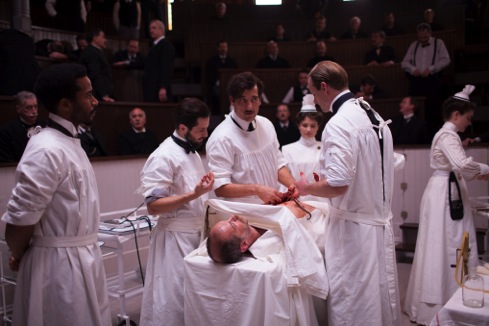
New York City, 1900: A mustachioed Clive Owen is at the center of The Knickerbocker Hospital’s theater of operations. Cinemax photo
Premiering: Friday, Aug. 8th at 9 p.m. (central) on Cinemax
Starring: Clive Owen, Andre Holland, Eve Hewson, Chris Sullivan, Cara Seymour, Jeremy Bobb, Juliet Rylance, Grainger Hines, Michael Angarano, Eric Johnson, David Fierro, Maya Kazan, Matt Frewer
Produced by: Jack Amiel, Michael Begler, Gregory Jacobs, Steven Soderbergh, Clive Owen, Michael Sugar
By ED BARK
@unclebarkycom on Twitter
Give the little girl with typhoid a teaspoon of turpentine every three hours but don’t call Dr. John Thackery in the morning. She’ll likely be dead by then and he’ll be shaking off his latest opium-induced stupor with a cocaine pick-me-up.
Such is the strong medicine of The Knick, which delves deeply and often gruesomely into surgery circa 1900 at New York City’s poor-side-of-town Knickerbocker Hospital.
This impressive 10-episode series, with a Season 2 already ordered, also throws Cinemax into the burgeoning mix of networks with Emmy-caliber dramas. WGN America newly joined this party last month with Manhattan. HBO, Showtime, FX, AMC, BBC America, Sundance TV, PBS and Netflix (technically a “streamer”) are some of the other purveyors of high quality originals. Television critics and certainly Emmy voters increasingly are of a mood to cry “Uncle.” How’s anyone supposed to keep up?
The Knick’s only marquee name is Clive Owen as the supremely talented, deeply flawed Dr. Thackery. Some viewers also might recognize Matt Frewer in a recurring role as his mentor, Dr. “Jules” Christiansen. But Frewer is sporting a bald pate and sprawling facial hair, making him almost as initially unrecognizable as a very bushy-bearded Daniel Stern in Manhattan.
Seven episodes were made available for review, and the entire Season 1 output is directed by Steven Soderbergh (Traffic and HBO’s recent Behind the Candelabra). A quirky soundtrack and some camera tricks are part of the bargain with The Knick, which by Episode 7 seemingly has diffused a good deal of its dramatic tension via various meetings of the minds. So some re-stirring of the pot and the plot will be both a challenge and a necessity.
Owen’s Thackery is a magnetic character whose dedication to his craft is matched only by his fondness for China Town’s drug-fueled brothels. He’s also a bigot who flatly refuses to accept a black doctor as his deputy chief of staff. “I don’t want you in my circus,” Thackeray tells Dr. Algernon Edwards (Andre Holland), a Harvard grad and visionary surgeon whose backing comes from The Knick’s major benefactors, the wealthy white Robertson family.
The clashes between Thackery and Edwards are the meat of The Knick. But an array of vivid supporting characters also make their marks.
Tom Cleary (Chris Sullivan) is the brutish, Bluto-like driver of a horse-drawn ambulance. He has a nose for underhanded deals and a fondness for robbing corpses of their valuables. His verbal sparring partner is tart Sister Harriet (Cara Seymour), who runs an orphanage linked to The Knick. Her secret life, uncovered by Cleary, leads to an unlikely partnership and some terrific scenes between the two.
Nurse Lucy Elkins (Eve Hewson), a drawler from West Virginia, endures a nasty dressing-down from Thackery in Friday’s Episode 1. Nonetheless she admires his brilliance. And by Episode 5, Lucy has brought a brief spasm of joy into his life by teaching Thackery to ride her trusty bicycle. This particular hour is uniformly strong, with a new contraption called an X-ray machine making its presence felt amid another dispiriting surgical setback for Thackery.
The Knick’s menagerie also includes shady hospital administrator Herman Barrow (Jeremy Bobb); young doctors “Bertie” Chickering, Jr. and Everett Gallinger (Michael Angarano, Eric Johnson); idealistic hospital board chairwoman Cornelia Patterson (Juliet Rylance); and sarcastic health inspector Jacob Speight (David Fierro), who’s a good deal of fun even while tracking down the city’s newly lethal “Typhoid Mary.”
The racism of the era is palpable throughout, with Dr. Edwards ostracized to the point of setting up his own clandestine treatment facility within the bowels of The Knick. As with Thackery, though, he also has his vices. Heavy drinking at a Tenderloin district bar invariably prompts him to seek out a fistfight. And he’s as deft with a punch as he is with a scalpel.
As noted in a previous post, a large percentage of cable’s notable drama series have sought out the past as more fertile ground than the present. The Knick is more about new frontiers than frontier medicine, even though its breakthrough surgeries are thoroughly primitive by today’s standards. They’re also very bloody, save for the starkest treatment of all after Thackery’s old girlfriend comes to visit him in Episode 3 while wearing blue-tinted glasses and a black prosthetic nose.
“You’re a good candidate for restoration but it won’t be an easy go,” he tells her after she reveals a jagged hole where her nose had been. It proves to be quite a procedure indeed.
By the end of Episode 7, however, The Knick also has sutured up some major story lines via a race riot that unites the key players in a color-blind effort to protect a group of injured black patients. Other liaisons then top things off, making one wonder whether the writers and the series may have peaked prematurely with three hours still to go this season and an order of 10 episodes for Season 2.
Whatever develops, the network still derided as “Skinemax” in some quarters finally has a top tier drama series of its own. The Knick towers above previous original dramas Strike Back and Banshee, giving Cinemax a gold star on an increasingly crowded boulevard of bravura television.
GRADE: A-minus
Email comments or questions to: unclebarky@verizon.net
Starz's romance-laced, time-traveling Outlander pokes along/perks up
08/06/14 09:44 AM
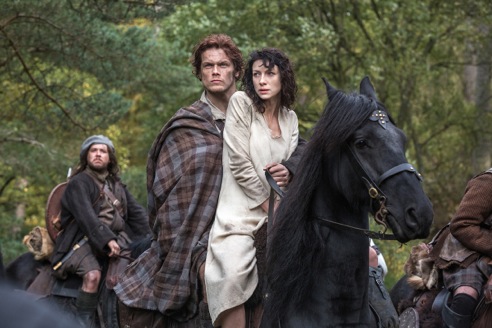
Premiering: Saturday, Aug. 9th at 8 p.m. (central) on Starz
Starring: Caitriona Balfe, Sam Heughan, Tobias Menzies, Gary Lewis, Graham McTavish, Lotte Verbeek, Annette Badland
Produced by: Ronald D. Moore, Paulo De Oliveira, Ira Steven Behr, Maril Davis, Toni Graphica, Anne Kenney
By ED BARK
@unclebarkycom on Twitter
The narrative voice can be its own form of flogging throughout Episode 1 of Starz’s Outlander.
In the person of heroine Claire Randall (Caitriona Balfe), it interjects over and over again in a very slowly unfolding table-setter for this otherwise picturesque adaptation of Diana Gabaldon’s string of romance-driven bestsellers. Be still my heart? No, but could we just get on with it? Setting the mood is one thing. Too much exposition is quite another.
By Episode 2, also sent for review, the action has picked up while all that off-camera droning has largely stifled itself. The Starz network, which for the most part has lived in the past with its original series, seems to be in no danger of having a Game of Thrones phenomenon on its hands. But it might have an involving swords ’n’ bodice tale in due time, with women composing the majority of Outlander’s audience after Starz’s bloody, brawny Spartacus series appealed mostly to men.
Claire is fated to be a time traveler after first emerging as a former World War II combat nurse, circa 1945. It’s six months after the war, and Britisher Claire has spent most of the past five years away from her husband, Frank (Tobias Menzies), who was an intelligence officer. They seek to re-connect during a second honeymoon jaunt through Inverness, Scotland. The physical attraction hasn’t flamed out. Or as Claire puts it, “Sex was our bridge back to one another, the one place where we always met.”
It’s otherwise nearing Halloween, with ghosts afoot in the form of play-acting townies. But first comes a visit to Castle Leoch, which is in ruins but also proves to be a suitable turn-on after Claire and Frank traipse around within.
Claire is starting to feel ill at ease and out of place, though. And sure enough, she’s finally magically transported to 1743 Scotland, where kilt-clad lads are squaring off against evil British Red Coats led by the twisted Jonathan Randall Esquire (also played by Menzies).
“I wanted it to be a dream but I knew it wasn’t,” Claire needlessly narrates. She also again spouts her favorite exclamation -- “Jesus H. Roosevelt Christ!” -- when a rough-hewn band of Scottish freedom-fighters is clueless to her demands for medical supplies to treat the injured and very handsome Jamie Fraser (Sam Heughan). It’s at this moment that Outlander begins to perk up.
Episode 2 mostly takes place within Castle Leoch, where the outwardly benign Colum MacKenzie (Gary Lewis) rules a roost of unruly Scots. Still tending to Jamie’s wounds, Claire learns of his previous capture by the British, who flogged him both before and after his sister was raped. He promises she’ll be safe in his company. Those familiar with the books -- or those who have never read a page of them -- will have no trouble deducing that a coupling’s a comin’.
Outlander also includes a kindly, roly-poly cook, Mrs. Fitzgibbons (Annette Badland), who encourages Claire to “call ‘oot’ if you need anythin’ else.” What she wants most of all is safe transport back to England. But Claire’s prowess as a “healer” and suspicions that she could be a spy are conspiring against any easy way outs.
Balfe is fine -- but not dandy -- as Outlander’s central character. The most effective performance so far is from Lewis as the skeptical Colum, whose legs are badly bowed from a degenerative disease. He conveys a sense of both fairness and menace, running Castle Leoch with a hand that is far steadier than his feet.
Outlander is beautifully shot throughout, which somewhat makes up for some of the early tedium. It may not ever rise to the level of enthralling. But by the second episode, the story at hand is flexing a firmer grip.
GRADE: B-minus
Email comments or questions to: unclebarky@verizon.net
Abbreviated Season 4 of Netflix's The Killing strives to pick up pieces from AMC's Season 3 (warning: don't read if you don't yet want to know how Season 3 ended)
08/05/14 09:12 AM
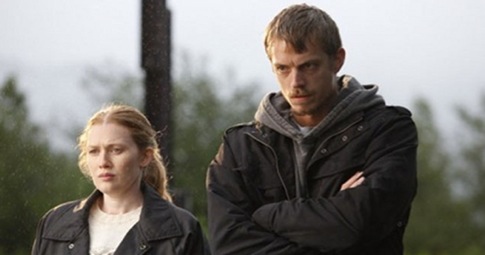
By ED BARK
@unclebarkycom on Twitter
Twice canceled by AMC and buried before that by some critics, The Killing lives on for a supposed final six-episode fourth season on Netflix.
It’s hard to imagine any more afterlives for emotionally scarred, rain-drenched Seattle detectives Sarah Linden (Mireille Enos) and Stephen Holder (Joel Kinnaman). But with this series and these characters, never say never.
Netflix, which began streaming Season 4 on Aug. 1st, shares Amazon’s penchant for Kremlin-like secrecy when it comes to revealing how many people actually are watching their programming. So a big, clandestine groundswell of support for The Killing possibly could trigger yet another rebirth. This very much looks like the end, though. And there’s closure, too, for critics who charged The Killing with a capital crime after its failure to answer the central question of “Who Killed Rosie Larsen?” at the end of Season 1.
Those who watched the final episode of Season 3 know that its killer is Linden herself. She pumped two fatal slugs into her former detective partner and lover, Lt. James Skinner (Elias Kotas), after learning he was the “Pied Piper” serial killer of teenage prostitutes.
Season 4 picks up immediately where Season 3 left off while also adding a new murder case. Linden and Holder have disposed of Skinner’s body and are conspiring to cover up what happened to him. Meanwhile, they also find themselves at the scene of the mass murder of a prosperous family. Only the lone teenage son has survived, but with a bullet hole in his head. As did Billy Campbell’s mayoral candidate in Season 1, the kid rather quickly recovers and is soon back among the troubled students of a strict military school run by an iron-willed headmaster/taskmaster named Margaret Rayne (Joan Allen).
Kinnaman’s Holder retains his quippy, lippy gift of sardonic gab, which is a good thing. Enos’ Linden remains stricken-looking and very much in the running for TV’s Unfit Mother of the Year. It still rains a lot, but no one uses an umbrella. And of course Linden’s not about to let a smile be her umbrella. In the annals of sad-eyed ladies, she makes Claire Danes’ “cry-faced” Carrie Mathison of Homeland seem like a standup comic.
Holder and Linden track a wide variety of clues while also suffering separate meltdowns. They’re in turn being increasingly dogged by bossman Carl Reddick (Gregg Henry), who’s investigating what happened to Skinner.
Be assured that all of this is resolved in the end, although not always satisfyingly. Episode 5 in particular deteriorates into a ridiculous chase scene through the woods. A surprise cameo near the end of Episode 6 also borders on the absurd. Allen, a three-time Oscar nominee, keeps her countenance screwed tight but her character gets to be more than a little laughable down the stretch.
That said, I watched the whole thing in one big gulp, and willingly so. The Killing still has some pulling power, even if the initial thrill of Season 1 is long since gone.
Should this truly be the end, The Killing will have endured for 44 episodes, with the final hour directed by the esteemed Jonathan Demme (The Silence of the Lambs, Philadelphia). Now it’s time to give Kinnaman his own series. He could reprise a Holder-like character in a sunnier clime. Or better yet, cast him as the young Lou Solverson (initially played by Keith Carradine) in FX’s Season 2 of Fargo.
Whatever happens, Linden is best left out of the picture. Enos played the character as written, so she can’t entirely be blamed. But she’d be well-served to ditch those tourniquet-like cable knit sweaters and take a role that regularly requires her to laugh hysterically. Veena Sud, at the throttle of The Killing for all four seasons, deprived Enos of any levity in a role that ended up fencing her in. It would be a shame if she also lets it define her.
GRADE: B-minus
Email comments or questions to: unclebarky@verizon.net
Caught on tape and amplified anew: HBO's Nixon By Nixon: In His Own Words marks another resignation anniversary
08/04/14 09:26 AM
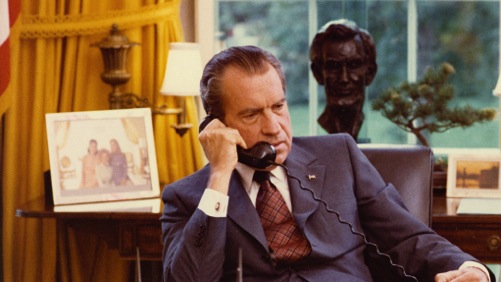
Richard Nixon in the Oval Office while bust of Abe Lincoln looks on. HBO photo
By ED BARK
@unclebarkycom on Twitter
Other presidents perhaps have said worse, but not for all to hear.
HBO’s latest In His Own Words documentary is an oral history of Richard Nixon timed to coincide with the 40th anniversary of his Aug. 9, 1974 resignation of the presidency at the height of the Watergate scandal. Nixon By Nixon (premiering on Monday, Aug. 4th at 8 p.m. central), does not suffer from a lack of material. It easily could stretch well beyond the allotted 75-minute running time, with 3,700 hours of Oval Office recordings to choose from in addition to Nixon’s other interviews with the news media he so detested.
Others are heard from as well, including former chief domestic advisor John Ehrlichman. He was one of many to be unaware of his boss’s taping mechanism, utilized from 1971 to ’73 as a means of preserving history. Ehrlichman, who died in 1999, hopes that a “committee of historians” someday will listen to all of the tapes before drawing their conclusions about Nixon. They’d come away seeing him as “the strangest paradoxical combination of any man I ever heard of. And they’d be right,” Ehrlichman says.
Most of the flash points in Nixon By Nixon are from his taped conversations. They’re skillfully illustrated and subtitled, although most of the audio is crystal clear. Nixon’s views, then and now, are often jarring.
“The Jews are born spies,” he says of Daniel Ellsberg’s leaking of The Pentagon Papers. “Most Jews are disloyal. Generally speaking, you can’t trust the bastards. They turn on you.”
Discussing his intention to name Romana Banuelos as treasury secretary, Nixon says that Mexicans at least “don’t live like a bunch of dogs, which the Negroes do live like. We’re gonna put more of these little Negro bastards on the welfare rolls at twenty-four hundred dollars a family.”
The major networks at the time -- CBS, NBC and ABC -- were fouled by anchors and reporters out to get him, Nixon tells special counsel Charles Colson, another of those who didn’t know they were being taped. “There’s not a good one on the whole Goddamn three networks. Not one.”
Nixon then ticks off the names of Walter Cronkite, Dan Rather, Harry Reasoner, John Chancellor, Daniel Schorr and Eric Sevareid as some of his principal antagonists.
Rather, the only current-day survivor of this group, is “just a sonofabitch, don’t you think?” he asks Colson.
Colson agrees, adding that Rather is also a “bastard.”
Nixon is more cordial in conversations with his wife, Pat, and daughter, Julie. But although friendly, their exchanges are also perfunctory. The president obviously had a lot on his mind. So when Tricia happily asks him about going to Trader Vic’s for a family dinner, he agrees without any extended chit-chat. Julie quickly signs off, seeming to know when their “conversation” has run its course.
Although the Watergate era does not lack for publicity, it’s easy to forget some of Nixon’s more striking on-camera moments. Introducing the Ray Coniff Singers for a performance at the White House, he tells the gathering, “And if the music is square, it’s because I like it square.”
But he doesn’t account for Carole Feraci, a Coniff singer with an agenda. She has both a sign -- “Stop the Killing” -- and a stream of verbiage that includes, “President Nixon, stop bombing human beings, animals and vegetation … If Jesus Christ were here tonight, you would not dare to drop another bomb.”
Amazingly, the performance then begins as if nothing untoward had happened, with Feraci joining her mates in singing the very square “Ma, He’s Making Eyes at Me.”
The following day, on a White House tape, Nixon calls her “the bitch.”
Near the end, he also lets his contempt for the media flare up at a White House press conference. Told by one reporter that he seemed to be angry at the coverage of his administration, the president says with a smile, ”One can only be angry with those he respects.”
Nixon By Nixon is produced and directed by Peter Kunhardt, whose work for HBO also includes oral histories of John, Robert and Edward Kennedy, and Gloria Steinem. And although it’s been told many times many ways, Kunhardt’s up-close look at the only American president ever to resign from office is absorbing from its opening minutes to the dark denouement.
Nixon, who died in 1994 and fought against his tapes going public, says in a table-setting interview that he went into politics after dropping what seemed to be a promising musical career.
“Sometimes I rather regret it,” he adds.
So do those of us who lived through Nixon’s life, times, prejudices and deceptions, which are amplified anew in this anniversary week by the tapes he came to see as a “probably stupid” idea.
GRADE: A-minus
Email comments or questions to: unclebarky@verizon.net
